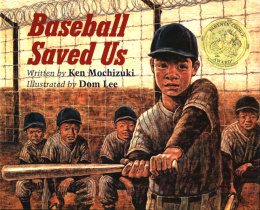Baseball Saved Us (book)
| Title | Baseball Saved Us |
|---|---|
| Author | Ken Mochizuki |
| Illustrator | Dom Lee |
| Original Publisher | Lee & Low |
| Original Publication Date | 1993 |
| Pages | 32 |
| WorldCat Link | http://www.worldcat.org/title/baseball-saved-us/oclc/26503118/editions |
Popular and acclaimed children's picture book written by Ken Mochizuki and illustrated by Dom Lee about the concentration camps and their aftermath through the prism of baseball.
A journalist and actor, author Mochizuki was approached by Philip Lee, founder of the new multicultural children's book publisher Lee & Low Books about writing a children's book based on baseball in the concentration camps. In producing the book, he worked with illustrator Lee, a Korean immigrant who did research for the book by looking at Ansel Adams ' photos of Manzanar ; some of his scratchboard and oil images for the book were inspired by Adams' images.
The book is told in the first person voice of Shorty, a young Japanese American boy. After a brief introduction that gives some of the historical background of the incarceration, the book traces Shorty's family's forced removal from their home to the former horse stalls of an " assembly center ," then to a desert concentration camp. His narrative notes the harsh weather conditions, dust storms, guard towers, lines and lack of privacy. To help alleviate the tedium of the camp, his father enlists other inmates in building a baseball field, which helps swing the mood of the camp. Though not a good player, Shorty plays on and improbably hits a home run in the championship game. After the war and out of the camps, Shorty finds himself in another important baseball game before a crowd that jeers him with racial epithets. He draws on his camp experience in playing through the crowd and the opposition in the book's climax.
The book received a warm response from critics and public, selling over half-a-million copies and becoming the best selling book in the entire Lee & Low catalog. [1] It received a boost from a positive review by Ira Berkow in the New York Times , who wrote that Mochizuki "captures the confusion, wonder and terror of a small child in such stunning circumstances with convincing understatement." [2] Nearly all other reviews were positive, including Karleen Chinen's in the Hawaii Herald ; she called it "uplifting and inspirational" and a "homerun of a story." [3] Among the more mixed reviews, Roger Sutton in Bulletin of the Center for Children's Books found the storyline "dated and sentimental," while the reviewer for Publishers Weekly felt there was too much exposition and background and not enough story. [4] Illustrator Lee's work also drew praise, with reviewers noting his clever use of color to reflect the shifting mood of the story. [5]
Mochizuki and Lee have collaborated on several other titles for Lee & Low, including Heroes (1995), on children learning of the postwar legacy of Nisei veterans. Mochizuki also adopted Baseball Saved Us into a children's play in 2003.
A fixture on children's reading lists, the book was briefly in the news in 2008 when parents in the New Milford school district in Connecticut requested that the book be taken off the second grade reading list because of its use of the racial slur "Jap." [6]
Several other fictional works have since taken on the topic of baseball in the concentration camps, including Suitcase Sefton and the American Dream: A Novel by Jay Feldman (Chicago: Triumph Books, 2006); The Lucky Baseball: My Story in a Japanese-American Internment Camp by Suzanne Lieurance (Berkeley Heights, N.J.: Enslow Publishers, 2010) and Barbed Wire Baseball by Marissa Moss and illustrated by Yuko Shimizu (New York: Abrams Books, 2013).
Find in the Digital Library of Japanese American Incarceration
This item has been made freely available in the Digital Library of Japanese American Incarceration , a collaborative project with Internet Archive .
Might also like: Barbed Wire Baseball by Marissa Moss; The Bracelet by Yoshiko Uchida; Fish for Jimmy by Katie Yamasaki
Related Articles
For More Information
Lee & Low Books Reading Guide. http://www.leeandlow.com/images/pdfs/baseball.pdf
Ken Mochizuki website. http://kenmochizuki.com/ .
Footnotes
- ↑ Ken Mochizuki website, accessed on April 9, 2015 at http://kenmochizuki.com/book.htm ; International Examiner , June 7–20, 2008, 3.
- ↑ Ira Berkow, New York Times , Apr. 4, 1993, accessed on April 9, 2015 at http://www.nytimes.com/1993/04/04/books/children-s-books-023693.html .
- ↑ Karleen Chinen, Hawaii Herald , Sept. 17, 1993, A-7. Other positive reviews include those by Ellen Fader, Horn Book Magazine 69.4 (1993): 453–54; Tom S. Hulburt in School Library Journal , June 1, 1993, 84–85; Hazel Rochman, Booklist , Apr. 15, 1993, accessed on April 9, 2015 at http://booklistonline.com/Baseball-Saved-Us-Ken-Mochizuki/pid=945440 ; and an unsigned review in Kirkus Reviews , Mar. 15, 1993, accessed on Apr. 9, 2015 at https://www.kirkusreviews.com/book-reviews/ken-mochizuki/baseball-saved-us/ .
- ↑ Sutton cited in "Ken Mochizuki," Contemporary Authors Online, Thomson Gale, 2008; Publisher Weekly , March 29, 1993, 55, accessed on Apr. 9, 2015 at http://www.publishersweekly.com/978-1-880000-01-4 .
- ↑ Fader, Horn Book Magazine ; Hurlburt, School Library Journal ; Kirkus .
- ↑ International Examiner , June 7–20, 2008.
Last updated Dec. 11, 2023, 8:07 p.m..

 Media
Media